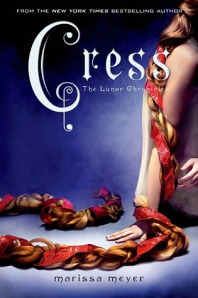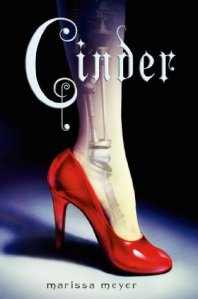 Scarlet by Marissa Meyer
Scarlet by Marissa Meyer
My rating: 3/5 Stars
Publisher: Feiwel & Friends (February 2013)
Length: 454 pgs
Series: The Lunar Chronicles, #2
Format: Paperback, purchased from my local independent bookstore
Goodreads Synopsis: Cinder, the cyborg mechanic, returns in the second thrilling installment of the bestselling Lunar Chronicles. She’s trying to break out of prison–even though if she succeeds, she’ll be the Commonwealth’s most wanted fugitive. Halfway around the world, Scarlet Benoit’s grandmother is missing. It turns out there are many things Scarlet doesn’t know about her grandmother or the grave danger she has lived in her whole life. When Scarlet encounters Wolf, a street fighter who may have information as to her grandmother’s whereabouts, she is loath to trust this stranger, but is inexplicably drawn to him, and he to her. As Scarlet and Wolf unravel one mystery, they encounter another when they meet Cinder. Now, all of them must stay one step ahead of the vicious Lunar Queen Levana, who will do anything for the handsome Prince Kai to become her husband, her king, her prisoner.
My Review:
Oh, Scarlet. I wanted to love you so so so much. I couldn’t put Cinder down, and after checking it out from the library I decided it was a series I had to start investing in, so I immediately purchased Scarlet and Cress. Am I still enthralled with the Lunar Chronicles? Definitely. Was I a little disappointed with the second installment? Yes.
Now don’t get me wrong, there’s so many wonderful things about this book and about this series. Meyer manages to weaves Scarlet’s storyline, a girl who lives on a farm in rural France, seamlessly with the drama that’s transpiring in New Beijing with Cinder, Emperor Kai, and Queen Levana. It feels like Meyer didn’t add anything awkwardly on in the sequel that she hadn’t initially planned already, which is great, as it shows that she’s put a lot of forethought into the series (I’ve already picked up on clues that I’m certain will appear in Cress). Scarlet was a really fun and original take on the Little Red Riding Hood story, and the plot lines were a lot less predictable than those in Cinder (which I had figured out less than halfway throughout the book). There were several plot twists withing Scarlet that I didn’t anticipate, and it’s action packed despite taking place over the course of a little over 24 hours. Meyer had great character development in this book, and writing interesting characters seems to be a strength of hers. Here’s a round-up of the fantastic characters worth reading in Scarlet:
Character Round-up
Scarlet- Scarlet is independent, sassy, fiery (just like her hair) and has unwavering determination. In a lot of ways she’s similar to Cinder, being a great, proactive female protagonist with her own mind and agency. However, Scarlet is very impulsive while Cinder is thoughtful and cautious, and I sometimes wanted to shake her from her stubborn mindset and the risky decisions she barreled into head on.
Wolf- Wolf has received a lot of love amongst fans, and it’s easy to see why. His character is wonderfully complex, and he shifts from aggressive and wild to vulnerable and haunted multiple times withing the book. He’s kind of an anti-hero, and his allegiances are tricky to figure out. Even by the end of the book Wolf is still an enigma, in my edition there was a short story titled “The Queen’s Army” which gives a lot more background on Wolf.
Thorne- At first Thorne annoyed me, but by the end of the series I grew to love him as the essential comic relief juxtaposed to Cinder’s seriousness. He’s a pompous mixture between Gilderoy Lockhart and Sturmhond from Siege and Storm by Leigh Bardugo. Also, he’s the only American in the series so far, so do what you want with that.
Queen Levana- Scarlet and “The Queen’s Army” short story at the end of my edition of Scarlet provide readers with the faintest cracks in the shiny, perfect veneer that encompasses the Lunar Queen. We see her in her natural habitat of Luna, and we start gaining insight into her mind through the perspective switch. That’s the nice thing about Meyer’s writing style is that she returns to the third person narration that is so lost within the YA fantasy genre. It allows her to enter different perspectives and follow different characters without sounding phony with multiple first person narrators.
Sacrlet has so much to offer- a wider look at the world after the fourth world war, the first scenes set in Luna, a storyline that strongly builds upon it’s predecessor, and vital information about Cinder’s past (such as how her surgeries were performed and why she has no memory prior to age 11). Yet it was only a three star read for me despite these great attributes because the beginning and middle really dragged for me. There was a lot of wandering around the forest and hiding from androids by Wolf and Scarlet, and though I like them both as characters, I felt that their “falling in love” was really unrealistic, especially considering the book takes place mostly over a 24 hour period. It was like they had a few interactions and all of the sudden they have these feelings for each other and I’m so confused because I barely remember how a romance between them even developed (insta-love at its finest I suppose). I think it was jarring because it was a big chance from Cinder where Cinder and Kai’s relationship slowly developed throughout the course of the book and is still in it’s fundamental developmental stages. So by the middle of Cinder I was dying to reach a chapter that switched to following Cinder and Thorne because it was so much more interesting to the awkward tension and creeping through the forest of Wolf and Scarlet’s plotlines.
Yet once everyone arrives in Paris things really picked up, and there were some great plot twists, lots of action, vital pieces of the puzzle came together, and I was hooked by the time the book finished. The Lunar Chronicles Series is still one of my favorites that I’ve discovered so far this year, and I’m eager to read Cress as well as anything else Meyer writes. I often times find the second book in a series to drag the most, so perhaps that’s what Meyer encountered (and to be fair, there was a lot of wandering through the forest in the original Little Red Riding Hood story). Scarlet is worth the read and worth continuing the series, it’s just not as engrossing as it’s predecessor Cinder. And if you can get your hands on the short story “The Queen’s Army” I’d highly recommend it, as it not only gives more insight to Wolf’s backstory, Levana, and Luna, but it brings up a lot of deeper topics in the series, such as bodily mutilation, a the creation and treatment of cyborgs, societal duty vs personal autonomy, and the toll of violence on the individual.
I would definitely recommend the Lunar Chronicles to anyone who loves YA dystopian, sci-fi, YA fantasy, and creative re-tellings of classic fairy tales (such as Once Upon a Time fans). I’m glad I’ve chosen to invest in this series, but had Scarlet been a standalone book I probably wouldn’t have bought it.
I was just recently made aware that the Lunar Chronicles are available in audio format from Macmillan Audio via Soundcloud, and that the first chapter of Scarlet can be previewed here. You can also check out the clip below! If you’re a fan of the Lunar Chronicles, check it out! To read my review of Scarlet, click here.
*The link to the Scarlet audiobook was provided to me by Macmillan Audio for an honest review. No compensation was received for my inclusion of the content.



